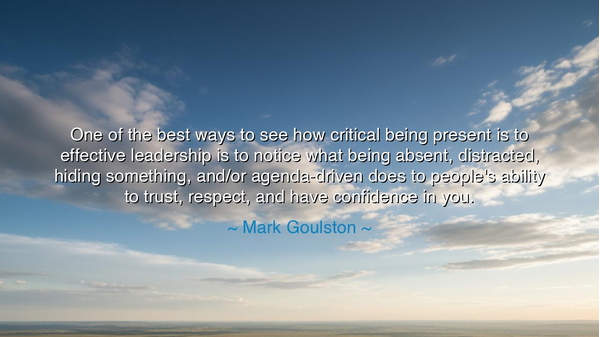
One of the best ways to see how critical being present is to
One of the best ways to see how critical being present is to effective leadership is to notice what being absent, distracted, hiding something, and/or agenda-driven does to people's ability to trust, respect, and have confidence in you.






Hear the words of Mark Goulston, a physician of the soul and teacher of leaders, who declared: “One of the best ways to see how critical being present is to effective leadership is to notice what being absent, distracted, hiding something, and/or agenda-driven does to people’s ability to trust, respect, and have confidence in you.” In these words lies a mirror for every leader, for they remind us that power is not merely about command, but about presence—about the ability to give one’s whole self to those who follow.
From the earliest days, the ancients understood this truth. A king who sat among his people, who listened to their grievances at the city gates, earned their loyalty more than one who ruled from a distant throne. The present leader embodies stability, while the absent one becomes a shadow, and shadows cannot guide. Thus Goulston warns that distraction, deceit, or hidden agendas corrode the very pillars upon which leadership rests: trust, respect, and confidence.
Consider the tale of Julius Caesar. Whatever judgment history gives his ambition, no one doubted his presence. He marched with his soldiers, endured their hardships, shared in their victories. His men trusted him because he was there, body and spirit, in the dust of the battlefield. Contrast him with later emperors who hid behind their walls, consumed by secret plots and selfish designs. Their absence bred suspicion, their duplicity bred contempt, and their legacies dissolved into ruin. In this contrast, Goulston’s wisdom gleams: presence builds confidence, absence destroys it.
Presence is not merely physical, but of the heart and mind. A parent who sits beside a child but keeps eyes fixed on distractions is not truly present. A leader who nods while hiding hidden motives is not truly authentic. Goulston reminds us that people can feel the difference—humans have always sensed when words are hollow and when attention is divided. The result is the withering of trust, and without trust, no leadership endures.
The lesson resounds beyond thrones and battlefields, into every place of influence. In a workplace, when a manager hides behind closed doors or speaks only in agenda-driven tones, their team loses respect. In families, when one hides truths or gives only partial presence, confidence fades. In communities, when leaders vanish in times of trial, the people scatter. To be fully present—to give time, attention, honesty—is the strongest form of leadership, for it binds people not by fear, but by devotion.
Therefore, O listener, learn this teaching well: guard yourself against distraction, against the temptation to hide, against the lure of hidden agendas. When you stand before others, give them your full presence. When you speak, let your words flow from honesty. When you lead, let your eyes and heart rest on those you serve. For only then will you be followed not out of compulsion, but out of love and confidence.
Thus, let Mark Goulston’s words endure as a torch for future generations: leadership is not only about strength of vision, but strength of presence. Be there in body, in mind, in heart. For absence breeds suspicion, distraction breeds weakness, deceit breeds collapse—but presence, honest and undivided, gives rise to trust, respect, and unshakable confidence. This is the legacy of true leadership: not hidden power, but visible presence, remembered in the hearts of those who followed.






AAdministratorAdministrator
Welcome, honored guests. Please leave a comment, we will respond soon